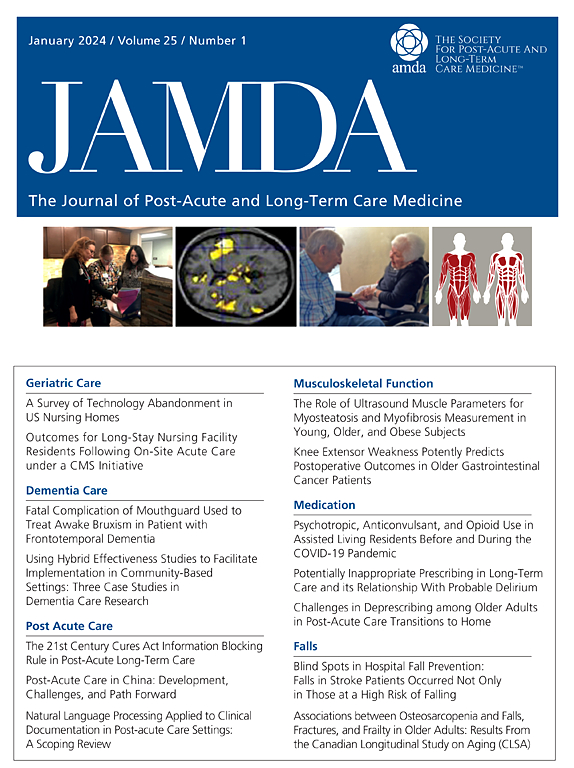Gender Differences in Frailty Progression and Recovery in Older Adults in Long-Term Care
IF 3.8
2区 医学
Q2 GERIATRICS & GERONTOLOGY
Journal of the American Medical Directors Association
Pub Date : 2025-08-01
DOI:10.1016/j.jamda.2025.105756
引用次数: 0
Abstract
Objectives
To examine gender differences in frailty transitions in relation to predictive factors and outcomes.
Design
Retrospective analysis of long-term care data.
Setting and Participants
Older residents (men = 10,683; women = 18,976; aged ≥65 years) were assessed annually over 3 years.
Methods
A deficit accumulation frailty index was constructed using 43 health measures. Trajectories among frailty states and mortality were evaluated by comparing women and men. Probabilities of frailty state transitions and odds of death were evaluated using Poisson and Logistic regressions. Covariates included baseline frailty, age, admission year, education, and marital status.
Results
The 3-year mortality rate was 29% in women and 37% in men; each additional health deficit at baseline increased the odds of mortality by 13% in both genders. Frailty trajectories were dominated by stabilization (46%), whereas 16% showed an improvement and 38% showed a decline. An increase in deficits at baseline was associated with a 58% increase in deficits after 3 years for women (67%, 57%, and 47% in 1, 2, and 3 years, respectively), with similar trends observed for men. Age advancement increased deficit counts by 3% in women and 4% in men, and the odds of death increased by 4% in women and 6% in men. Residents with high school or more education showed a greater risk of health decline in 1 year (23% in women, 35% in men). Being married increased the risk of health decline for 73% in women and 72% in men.
Conclusions and Implications
Frailty affected health transitions and mortality in long-term care. Older residents who were less frail at admission were more likely to maintain or improve their health status. Education and marriage had gender-specific effects on health changes. These findings inform management strategies targeting frailty and demographic profiles.
老年人长期护理中衰弱进展和恢复的性别差异。
目的:探讨与预测因素和结果相关的脆弱转变的性别差异。设计:对长期护理资料进行回顾性分析。环境和参与者:老年人(男性= 10683;女性= 18,976;≥65岁)在3年内每年评估一次。方法:采用43项健康指标构建缺陷积累脆弱指数。通过比较女性和男性来评估四种虚弱状态和死亡率的轨迹。使用泊松回归和逻辑回归评估衰弱转变概率和死亡几率。协变量包括基线虚弱、年龄、入院年份、教育程度和婚姻状况。结果:3年死亡率女性为29%,男性为37%;在基线水平上,每增加一个健康缺陷,男女死亡率就增加13%。在幸存者中,脆弱的轨迹主要是稳定(46%),而16%的人表现出改善,38%的人表现出下降。基线时的赤字增加与女性3年后赤字增加58%相关(1、2和3年分别为67%、57%和47%),男性也有类似的趋势。随着年龄的增长,赤字在女性中增加了3%,在男性中增加了4%,死亡的几率在女性中增加了4%,在男性中增加了6%。受过高中或以上教育的居民在一年内健康下降的风险更大(女性23%,男性35%)。结婚增加了73%的女性和72%的男性健康下降的风险。结论和意义:虚弱影响健康变化和死亡率;那些不那么虚弱的人更有可能保持/改善。教育和婚姻对健康变化产生了针对不同性别的影响。这些发现启发了针对脆弱和人口特征的管理策略。
本文章由计算机程序翻译,如有差异,请以英文原文为准。
求助全文
约1分钟内获得全文
求助全文
来源期刊
CiteScore
11.10
自引率
6.60%
发文量
472
审稿时长
44 days
期刊介绍:
JAMDA, the official journal of AMDA - The Society for Post-Acute and Long-Term Care Medicine, is a leading peer-reviewed publication that offers practical information and research geared towards healthcare professionals in the post-acute and long-term care fields. It is also a valuable resource for policy-makers, organizational leaders, educators, and advocates.
The journal provides essential information for various healthcare professionals such as medical directors, attending physicians, nurses, consultant pharmacists, geriatric psychiatrists, nurse practitioners, physician assistants, physical and occupational therapists, social workers, and others involved in providing, overseeing, and promoting quality

 求助内容:
求助内容: 应助结果提醒方式:
应助结果提醒方式:


